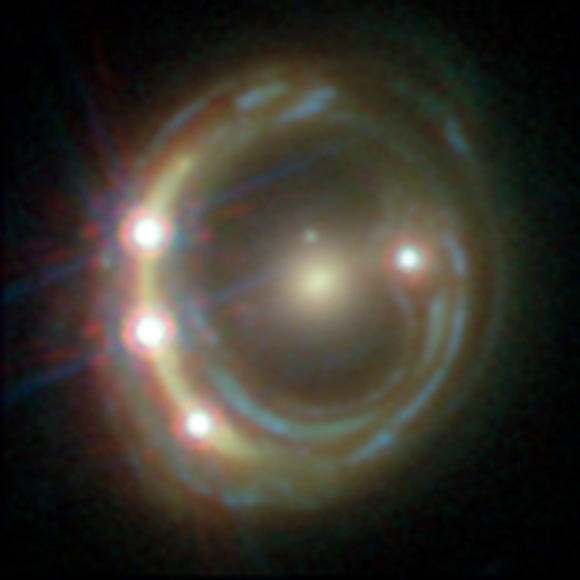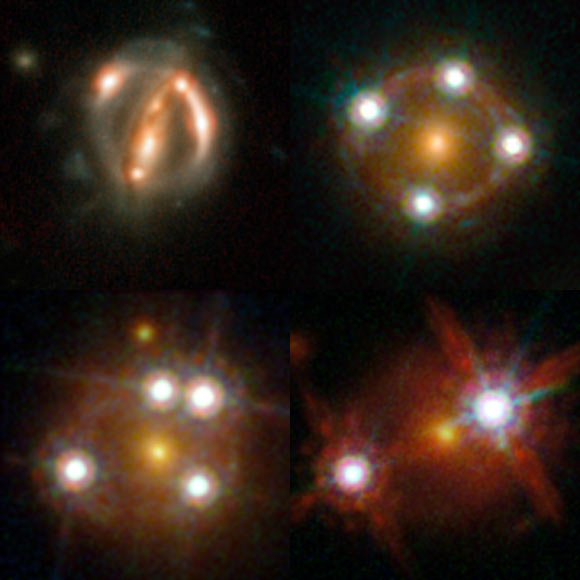Astronomers from the international H0LiCOW (H0 Lenses in COSMOGRAIL’s Wellspring) collaboration have made a new measurement of the Hubble constant — a fundamental quantity that describes the rate at which the Universe is expanding — and it doesn’t quite line up with a different estimate of the same number. That discrepancy could hint at ‘new physics’ beyond the Standard Cosmological Model.

RXJ1131-1231 is among the five best lensed quasars discovered to date. The foreground galaxy smears the image of the background quasar into a bright arc (left) and creates a total of four images — three of which can be seen within the arc. Image credit: NASA / ESA / Hubble / S.H. Suyu et al.
The Hubble constant is one of the fundamental quantities describing our Universe.
“The Hubble constant is crucial for modern astronomy as it can help to confirm or refute whether our picture of the Universe — composed of dark energy, dark matter and normal matter — is actually correct, or if we are missing something fundamental,” said Dr. Sherry Suyu of the Max Planck Institute for Astrophysics, lead researcher on the collaboration.
The H0LiCOW team used the NASA/ESA Hubble Space Telescope and several other space- and ground-based telescopes to observe five galaxies in order to arrive at a new measurement of the constant.
The new result is entirely independent and agrees with other measurements of the Hubble constant in the local Universe, measurements that used as their reference points Cepheid variable stars and supernovae.
However, the findings from the team, as well as those from the Cepheids and supernovae, differed from those made previously by ESA’s Planck satellite — in the latter case, measurement of the Hubble constant was made for the early Universe by observing the Cosmic Microwave Background (CMB).
While the Planck measurements agree with our current understanding of the cosmos, the results emanating from measurements for the local Universe disagree with currently accepted theoretical models of the Universe.
“The expansion rate of the Universe is now starting to be measured in different ways with such high precision that actual discrepancies may possibly point towards new physics beyond our current knowledge of the Universe,” Dr. Suyu said.

This montage shows four lensed quasars and the foreground galaxies studied by the H0LICOW collaboration (from top left, clockwise): B1608+656 (two foreground galaxies smeared the light of the more distant quasar’s host galaxy into bright arcs); HE0435-1223 (foreground galaxy creates four almost evenly distributed images of the distant quasar around it); WFI2033-4723 (foreground galaxy creates four distinct images of the distant quasar around it); HE1104-1805 (foreground galaxy creates two distinct images of the distant quasar to both sides of it). Image credit: NASA / ESA / Hubble / S.H. Suyu et al.
The targets of the study were massive galaxies positioned between Earth and very distant quasars — incredibly luminous galaxy cores.
The light from the quasars is bent around the huge masses of the galaxies as a result of strong gravitational lensing. This creates multiple images of the background quasar, some smeared into extended arcs.
Because galaxies do not create perfectly spherical distortions in the fabric of space and the lensing galaxies and quasars are not perfectly aligned, the light from the different images of the background quasar follows paths which have slightly different lengths.
Since the brightness of quasars changes over time, astronomers can see the different images flicker at different times, the delays between them depending on the lengths of the paths the light has taken.
These delays are directly related to the value of the Hubble constant.
The Hubble constant estimate from H0LiCOW, 71.9±2.7 km per second per megaparsec, is accurate to 3.8%.
“To reach that accuracy, we even considered the lensing effects of all other nearby galaxies in our analysis,” said team member Dr. Stefan Hilbert, from the Excellence Cluster Universe.
“An accurate measurement of the Hubble constant is one of the most sought-after prizes in cosmological research today,” added team member Dr. Vivien Bonvin, from EPFL in Switzerland.
“The idea of measuring the Hubble constant using time delays between lensed images of quasars has been around for over 50 years, but it is only recently that such measurements have become possible, thanks to the efforts of our collaboration. The next goal will be to increase the number of lenses used for the analysis,” said team member Dr. Alessandro Sonnenfeld, from the Kavli Institute for the Physics and Mathematics of the Universe.
“The tension between local and CMB measurements of the Hubble constant is strengthened by the new strong lensing observations,” said team member Dr. Frederic Courbin, also from EPFL.
“The tension can be caused by new physics beyond the Standard Cosmological Model, in particular new forms of dark energy.”
The team’s findings will be published in five papers in the journal Monthly Notices of the Royal Astronomical Society.
_____
S.H. Suyu et al. 2017. H0LiCOW I. H0 Lenses in COSMOGRAIL’s Wellspring: Program Overview. MNRAS, submitted for publication; arXiv: 1607.00017
D. Sluse et al. 2017. H0LiCOW II. Spectroscopic survey and galaxy-group identification of the strong gravitational lens system HE0435-1223. MNRAS, submitted for publication; arXiv: 1607.00382
Cristian E. Rusu et al. 2017. H0LiCOW III. Quantifying the effect of mass along the line of sight to the gravitational lens HE 0435-1223 through weighted galaxy counts. MNRAS, submitted for publication; arXiv: 1607.01047
Kenneth C. Wong et al. 2017. H0LiCOW IV. Lens mass model of HE 0435-1223 and blind measurement of its time-delay distance for cosmology. MNRAS, accepted for publication; arXiv: 1607.01403
V. Bonvin et al. 2016. H0LiCOW – V. New COSMOGRAIL time delays of HE 0435−1223: H0 to 3.8 per cent precision from strong lensing in a flat ΛCDM model. MNRAS 465 (4): 4914-4930; doi: 10.1093/mnras/stw3006







